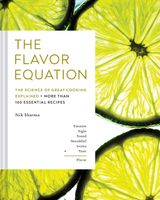Advertisement
Recipes + The Anatomy of Flavor
Appears in
By Nik Sharma
Published 2020

IF YOU LOOK CLOSELY AT ANY RECIPE, you’ll notice that the essential elements—headnote, ingredient list, and method—all work in concert to build flavor. The headnote reveals the inspiration or thinking behind the recipe, usually toward achieving a sensation or reliving a nostalgic taste memory.
The list of ingredients is more than just a list of amounts and the order in which they will be used; it also gives you some hints as to why an acid might be added at the start or toward the end of the recipe, or why spices are toasted, cooled, and ground. The method expands on the ingredient list and tells you exactly what to do with them. It gives you cooking time ranges as well as visual and sound cues. The method is where the flavor reactions occur; new flavor molecules are created, older ones might be modified, new textures are created—the complex set of aroma, taste, and pigment molecules created by the caramelization and Maillard reactions that happen when we heat our ingredients. And while the final look and taste of a dish might evoke memories, even rolling cookie dough during the holidays can bring back fond memories or become the stage for a new memory.

